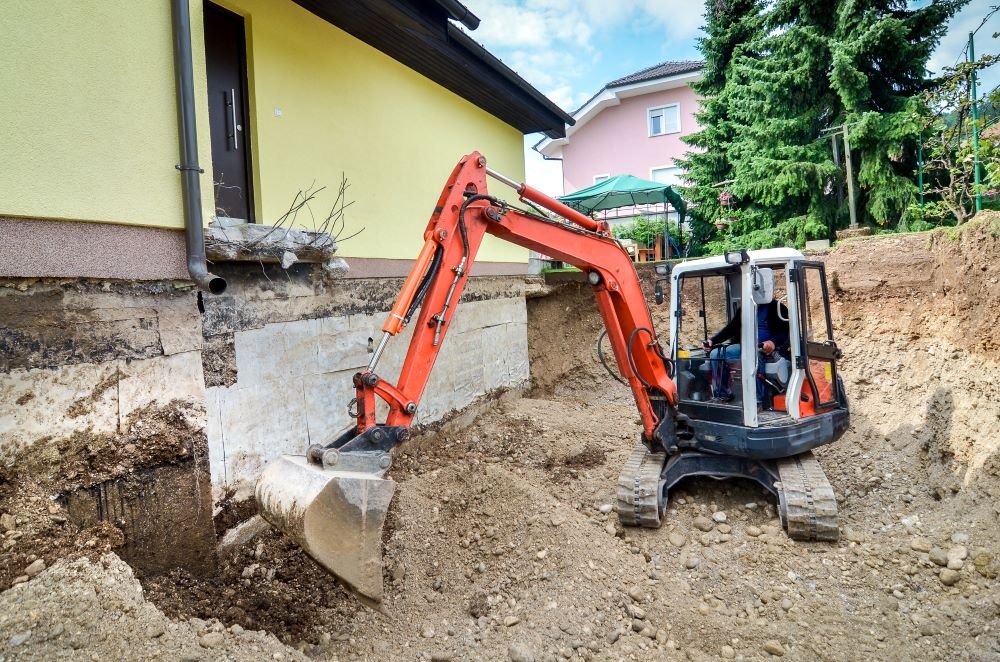There are three possible options to expand a building: upward, sideways, or… downward!
The latter method of increasing living space is very popular among property owners with crawl spaces or shallow basements. Indeed, digging out a basement to fully exploit its potential presents an opportunity to expand a residence and increase its value.
However, transforming these cramped and dark spaces into a comfortable basement is a complicated and sometimes risky project that must be undertaken by specialists.
In this article, discover how excavation and foundation professionals can dig out a crawl space or shallow basement to enlarge a house.
CHECKING THE FEASIBILITY OF THE PROJECT BEFORE DIGGING OUT A BASEMENT
As mentioned earlier, digging out a basement is a bold endeavor. Several obstacles can threaten this kind of project feasibility or at least prevent you from creating the new living space you’ve dreamed of.
That’s why, before digging out an existing basement, various checks must always be conducted, and several factors must be considered.
NATURE OF THE SOIL
In general, whether a property is built on clay soil or directly on rock, solutions exist to make basement excavation possible.
That said, if the soil to be excavated consists of sand or clay, it may be necessary to support the new foundation with piles driven into the rock to protect against soil subsidence caused by drought.
When digging into rock, the required excavation equipment is different since the stone needs to be broken.
One thing is certain: it is important to know the nature of the soil to plan adequately the construction of a basement under your house.
PLUMBING AND SEWAGE SYSTEMS
The feasibility of a basement expansion and development project may also depend on the property’s sewage and plumbing systems’ configuration. In reality, solutions (such as relocating pipes) can always be found, but these can sometimes be very expensive and reduce the available space.
For example, if the excavated basement level is lower than the drainage pipes that carry water away from the foundation drain, a sump pit will need to be installed, along with a pump capable of directing the water away from the house.
If the project involves increasing the basement height to install a bathroom, a pump will also be needed to evacuate wastewater to the municipal sewer or septic tank.
MUNICIPAL REGULATIONS AND THE NATIONAL BUILDING CODE
As with any construction or demolition project, a permit is required. Before digging out a basement, municipalities usually require various documents:
- An engineer’s plan for the structure;
- An architect’s or technologist’s plan for the interior layout;
- A contract with the excavation contractor of your choice;
- A certificate of location.
It is also important to know that the National Building Code has strict requirements regarding the minimum level of natural light certain rooms must receive. For example, a bedroom’s windows must account for at least 5% of its floor area. This figure rises to 10% for a dining room or living room.
BUDGET
The cost of an under-house basement construction varies depending on so many factors that it is difficult to estimate without an in-depth understanding of the project.
The cost of the work will vary based on the basement’s current configuration, the excavation depth, the amount of concrete to be replaced or added, and the presence of rock.
One thing is certain: the amount to be paid can quickly escalate, discouraging some homeowners who may opt for another way to expand their house.
TWO METHODS FOR DIGGING OUT A BASEMENT
Once the green light is given and basement excavation can begin, the residential excavation contractor will arrive on-site with the necessary equipment.
There are two methods for digging or increasing the height of a basement. However, regardless of the chosen strategy, it is essential to ensure that the building is well-supported during and after the work.
DISCOVER OUR RESIDENCIAL EXCAVATION SERVICES
LOWERING THE CONCRETE SLAB
In most residential buildings, an additional 15 to 30 cm of clearance can be gained simply by lowering the existing concrete slab. This method avoids the significant costs of underpinning work, but unfortunately, it does not always allow for full-height rooms.
To lower a concrete slab without causing subsidence, it is crucial to avoid disturbing the soil near the base of the foundation walls. Instead, the excavation contractor will dig the basement center. Then, around the perimeter, concrete will be poured at a 45-degree angle between the new slab and the base of the foundations.
UNDERPINNING WORK
To achieve a ceiling height of at least 8 feet (244 cm), the only real solution is underpinning work. This involves installing new concrete foundations beneath the existing ones.
To do this, the contractor must begin by excavating the basement center, ensuring that beams and other essential structural elements are well-supported to maintain the building’s stability.
They will then dig niches at a few points under the existing foundation walls to place metal posts and pour foundation sections approximately 140 cm wide.
The rest of the new foundations will then be excavated and poured section by section. Naturally, this process requires many precautions to prevent the ground from collapsing under the old foundations.
DIGGING OUT A BASEMENT WITH PARTY WALL FOUNDATIONS
Even if a building has party walls, as is often the case in Montreal, it is possible to transform its crawl space into a habitable basement.
Whether made of stone or concrete, party foundation walls are generally preserved to minimize the effects on adjacent buildings.
The front and rear foundation walls, on the other hand, are often completely redone. This makes it much easier to enlarge windows and install a membrane and French drain to waterproof house foundations from the outside.
In all cases, a 2.5 m wide section would have to be removed from a front or rear wall to allow excavation equipment to enter.
CONSIDERING DIGGING OUT YOUR BASEMENT? CALL OUR EXCAVATION SERVICES
In conclusion, digging out a basement or increasing its height requires meticulous planning, great expertise, and specialized equipment. This is not a project to be entrusted to amateurs.
If you are considering excavating your crawl space or shallow basement, entrust this task to an excavation company in Montreal or elsewhere in Quebec.
At Excavation Chanthier, we work closely with engineers and specialists in structure and foundations to successfully complete basement excavation projects. Contact us today to learn more about our services!


